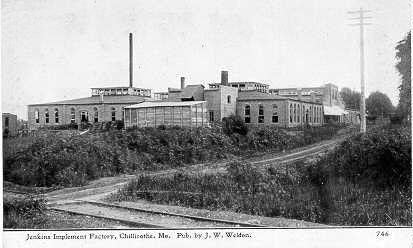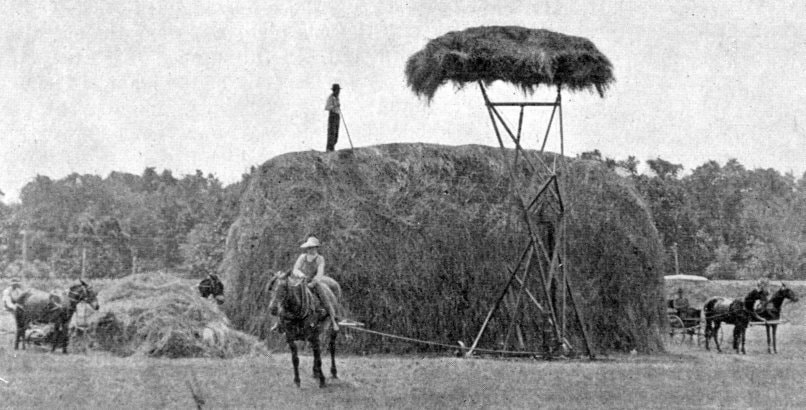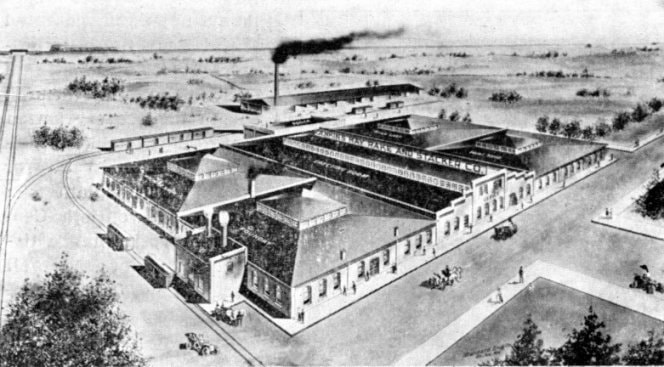Jenkins' Hay Rake and Stacker
In 1907 the Jenkins Hay Rake and Stacker Company, formerly of Browning, Missouri, was interested in moving to Chillicothe.[2] Inventor and owner Marion R. Jenkins liked Chillicothe due to its railroad facilities and the overall desirability of Chillicothe for raising his family.[3] He was a pioneer in the invention of sweep hay rakes and stackers, and received a patent in 1880.[4] He started his company in 1891 in Browning.[5]
In 1908, Jenkins built a new 25,000 square foot factory in Chillicothe, located at 101 Brunswick, just south of the Burlington and Wabash railroad tracks. The facility employed around 100 men. There were numerous departments within this factory, including a wood shop, paint shop, foundry shop, machine shop, engine room and office spaces. This new factory was “largest establishment of its kind in the west.”[6] Jenkins Hay Rake and Stacker Company sold machinery to all states west of the Mississippi as well as South America and Canada.[7]
Mr. Jenkins bought the Henry Wallbrunn home at 213 Locust Street for a sum of $7,000.[8] This was a brick home at the corner of Locust and Third Streets.
M. R. Jenkins died at his home on Locust St.[9] The factory which had at one time run day and night to keep up with orders, had not been active in the few years leading up to this death.
[1] 100 YEARS IN LIVINGSTON COUNTY, MISSOURI, Published by the Livingston County Bicentennial Agriculture Committee. July, 1976.
[2] Chillicothe Constitution-Tribune April 12, 1975
[3] Chillicothe Constitution Nov 2, 1905
[4] Constitution-Tribune April 12, 1975
[5] Chillicothe Constitution-Tribune Nov 18, 1931
[6] Chillicothe Constitution October 29, 1908
[7] Constitution-Tribune Nov 18, 1931
[8] Chillicothe Constitution Jan 14, 1908
[9] Constitution-Tribune Nov 18, 1931
In 1908, Jenkins built a new 25,000 square foot factory in Chillicothe, located at 101 Brunswick, just south of the Burlington and Wabash railroad tracks. The facility employed around 100 men. There were numerous departments within this factory, including a wood shop, paint shop, foundry shop, machine shop, engine room and office spaces. This new factory was “largest establishment of its kind in the west.”[6] Jenkins Hay Rake and Stacker Company sold machinery to all states west of the Mississippi as well as South America and Canada.[7]
Mr. Jenkins bought the Henry Wallbrunn home at 213 Locust Street for a sum of $7,000.[8] This was a brick home at the corner of Locust and Third Streets.
M. R. Jenkins died at his home on Locust St.[9] The factory which had at one time run day and night to keep up with orders, had not been active in the few years leading up to this death.
[1] 100 YEARS IN LIVINGSTON COUNTY, MISSOURI, Published by the Livingston County Bicentennial Agriculture Committee. July, 1976.
[2] Chillicothe Constitution-Tribune April 12, 1975
[3] Chillicothe Constitution Nov 2, 1905
[4] Constitution-Tribune April 12, 1975
[5] Chillicothe Constitution-Tribune Nov 18, 1931
[6] Chillicothe Constitution October 29, 1908
[7] Constitution-Tribune Nov 18, 1931
[8] Chillicothe Constitution Jan 14, 1908
[9] Constitution-Tribune Nov 18, 1931



